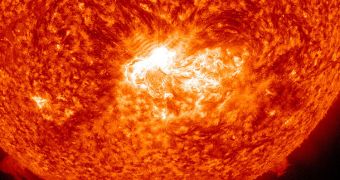Astronomers using the NASA Solar Dynamics Observatory (SDO) say that an impressive solar flare occurred earlier today, peaking at around 12:52 pm EDT (1652 GMT). Unlike the four recent solar flares that were produced last week, the new event did not originate from Active Region (AR) 1515.
According to scientists at the NASA Goddard Space Flight Center (GSFC), in Greenbelt, Maryland, the solar flare erupted from within AR 1520, an area of intense solar activity that came into view from behind the Sun about one week ago.
Measurements from the SDO indicate that a coronal mass ejection is associated with the July 12, X1.4-class solar flare. Events in this class are the most intense the Sun is capable of producing. The CME is made up of highly-charged particles, which are currently heading our way.
Estimates provided by the STEREO-B spacecraft, of the Solar Terrestrial Relations Observatory constellation, indicate that the CME is traveling at around 850 miles (1,370 kilometers) per second. At this point, experts have yet to release an estimate of when the particles hit.
However, we can expect to see intense aurora displays over the next couple of days, as the solar particles are captured by Earth's magnetic defenses, and redirected along its field lines. Satellite and power grid operators have already been alerted as to the heading of the CME.
If they catch us unprepared, these solar particle winds can cause significant damage, such as fry satellites in orbit, destroy transformers and other power grid components, hinder communications and endanger the lives of astronauts on the International Space Station.
The Sun is now more active than a few years back because it is nearing another peak in its 11-year cycle. Called a solar maximum, this stage in its life is characterized by tumultuous activity on its surface, the formation of multiple sunspots, and the release of many solar flares and CME.
Since July 2, the star has already released three M-class solar flares and an X-class one, all from AR 1515. Ironically, while experts were monitoring this sunspot, AR 1520 erupted, catching them by surprise.
This cycle's solar maximum is expected to be achieved later this year, or maybe by mid-2013. Beyond that time, the Sun's level of activity will decrease considerably over the years, as it heads towards a period of very low activity, called a solar minimum.

 14 DAY TRIAL //
14 DAY TRIAL //